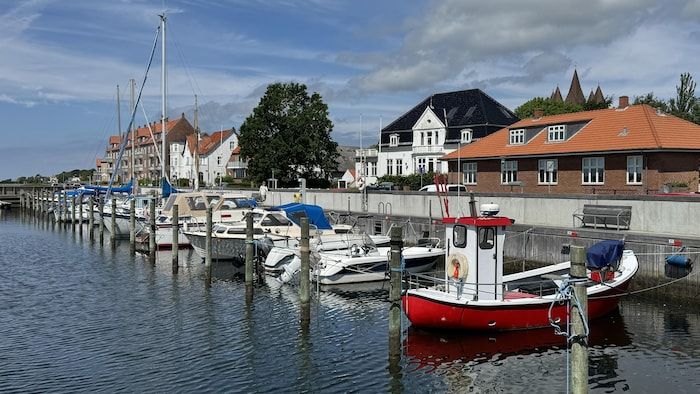Kalundborg, a small town located about a hundred kilometers from Copenhagen, owes its excellent economic health to a medicine, mainly sold abroad.
No other mayor in Denmark has seen anything like this
assures Martin Damm, the mayor of Kalundborg, guiding us on the roads, sometimes brand new, of his community.
A new factory is being built
explains the elected official as he approaches a huge construction site topped with cranes.
The report by Raphaël Bouvier-Auclair
Novo Nordisk, the company that created the drug Ozempic, an antidiabetic drug so widely used because it suppresses the appetite, has invested the equivalent of 11 billion Canadian dollars in these new facilities. Up to 1,500 new positions could be created.
The pharmaceutical giant has been based in Kalundborg for decades, but the international success of its product, particularly in the United States, is pushing it to expand.
Half of the world’s insulin comes from Kalundborg.
Open in full screen mode
Elected for years, the mayor of Kalundborg, Martin Damm, is witnessing the transformation of his city.
Photo: Radio-Canada / Raphaël Bouvier-Auclair
The company’s economic impact extends far beyond Kalundborg’s borders.
In fact, it is now the pharmaceutical sector that determines the state of the economic health of Denmark as a whole, says Jens Pedersen, chief analyst at Danske Bank.
This is what makes the difference between whether or not the Danish economy grows.
Last year, the Scandinavian country grew by 1.8%. However, without Novo Nordisk, there would have been no growth
, assures the economist. Denmark would thus have been faced with economic prospects similar to those of its neighbors, Germany and Sweden, which entered into recession.

Open in full screen mode
Novo Nordisk has invested billions of dollars in building a new factory in Kalundborg.
Photo: Radio-Canada / Raphaël Bouvier-Auclair
The challenges of growth
One thing is certain, in Kalundborg, the epicenter of Ozempic production, there is no doubt about the economic dynamism.
There was an explosion of people arriving
noted Ariadna Perez Montero, a young Belgian who came to settle in Kalundborg to carry out her biomedical studies.
Because in addition to Novo Nordisk, where Ariadna did an internship, many specialist companies as well as university campuses have set up shop in the small Danish town. A dozen universities have decided to have branches there.
There are thousands of people working there, students like me until the evening, the one who cleans the cleaners or the engineers or others.

Open in full screen mode
Ariadna Perez Montero is studying in Kalundborg, Denmark.
Photo: Radio-Canada / Raphaël Bouvier-Auclair
This influx of foreign brains unsurprisingly creates pressure on the city, as Mayor Martin Damm has noted for several years.
When you grow so quickly, there are several challenges, including housing
he says, also adding the need for new roads and other infrastructure in his city, whose agglomeration has around 50,000 inhabitants.

Open in full screen mode
Many housing units are being built in Kalundborg.
Photo: Radio-Canada / Raphaël Bouvier-Auclair
An economy too dependent?
Is the boom experienced by the small town and the entire Danish economy sustainable?
The question arises in the face of increasing dependence on the pharmaceutical industry alone.
In northern Europe, the parallel with the role played by Nokia in Finland is hard to ignore.
According to Finnish Economic Research Institutethe strength of the telecommunications giant contributed to the GDP Finnish economy grew by 25% between 1997 and 2007. But subsequently, the company’s difficulties would have contributed to an 8% fall in the same economy in 2009.
The similarity is that a very large company occupies a very large part of a country’s economy
assures economist Jens Pedersen, who notes however that, in the case of Novo Nordisk in Denmark, the prospects are encouraging for the coming years.
I think the priority is above all to benefit from the success of Novo Nordisk, which contributes to the growth of the economy and employment in Denmark
believes the expert.
The mayor of Kalundborg, Martin Damm, says he knows the risks of dependence on one sector.

Open in full screen mode
The port of Kalundborg, Denmark
Photo: Radio-Canada / Raphaël Bouvier-Auclair
The economy of its small port city has long been linked to the health of its maritime industry.
1930, everything collapsed”,”text”:”There was a shipyard and everyone worked there. But with the economic crisis in the 1930s, everything collapsed”}}”>There was a shipyard and everyone worked there. But with the economic crisis in the 1930s, everything collapsed
he explains.
History then repeated itself a few decades later with a short-lived invention in the hair care products industry.
In Denmark we say third time is a charm
assures Martin Damm, emphasizing the possibilities for diversifying Novo Nordisk’s activities through research.
Near the port of his city, recently converted into a swimming area thanks to the spin-offs of pharmaceutical activity, he is hopeful that history will not repeat itself.











